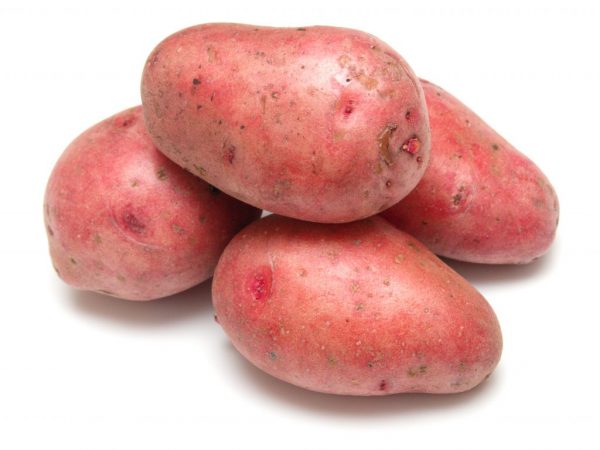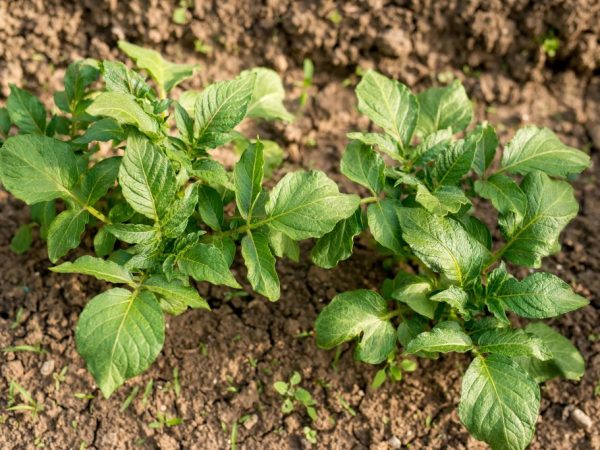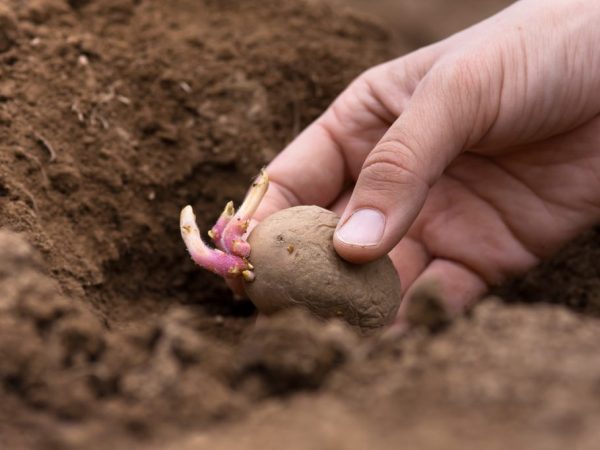Description of Rosar's potatoes
Rosar's potatoes have long been known to the general public. Was bred in Germany. Possesses high quality and taste indicators. Since 1996, the culture has been included in the Russian breeding register.

Description of Rosar's potatoes
Characteristics of potatoes
Rosar potatoes differ from other potato crops in their tuber color. In two adjacent bushes, tubers can be dark red or pink in color. On average, one potato weighs 100-130 g. The description in the breeding register says that all tubers have an even structure, the same size.
The Rosara potato variety is widely used by consumers. The low starch content in root crops makes it possible to make dried raw materials from potato tubers. The potato is not boiled soft and has an excellent taste.
Description of the plant:
- semi-spreading bushes;
- stems are erect, average height;
- inflorescences are pink-purple;
- the shape of the root crops is oblong, oval, medium in size;
- potatoes are covered with a smooth skin, with a slight roughness;
- the pulp is colored light yellow.
Rosar potatoes are early ripening varieties. From the moment of planting to a full harvest, 65-70 days pass. The biggest advantage is resistance to mechanical damage, potatoes are perfectly stored and withstand long-term transportation, despite early ripening. Often, early maturing varieties are stored much worse than others.
Advantages and disadvantages
Among the advantages of Rosary are:
- relative resistance to fungal diseases;
- good taste indicators;
- early ripening: 70 days after planting;
- high yield - 300-500 kg can be harvested from 1 hectare, depending on the growing area;
- no need for frequent change of planting material.
Among the disadvantages, many gardeners note that potatoes of this variety are not suitable for frying and are too susceptible to attacks by the Colorado potato beetle. However, this is one of the varieties that do not require special care. In Russia, Rosara is the most popular variety of potato crops, and a detailed description of this is confirmation.
Fertility
If all the requirements of agricultural technology are fulfilled, from one hundred square meters you can get up to 500 kg of excellent quality potatoes. The main thing is that the yield indicators will be maintained for 4-5 years, without changing the seed. The harvest is not affected by weather conditions.
The variety gives the highest yield in the middle latitudes. According to reviews of farmers growing the variety in northern latitudes, even with a significant temperature difference, there is no decrease in quality indicators, and the yield does not fall. High resistance to many diseases is the key to getting good potatoes.
Agrotechnical requirements

Some requirements must be met
To get root crops with excellent taste and quality indicators, it is necessary to comply with agrotechnical requirements. Usually, seed potatoes left over from the last harvest are used for planting. But, over time, you will have to change it, otherwise degeneration will begin: the potatoes will become smaller every year. Without renewal, Rosara Seeds can be used for 5 consecutive years.
Soil preparation
Most types of potatoes are whimsical to the soil composition, Rosara is no exception. Soil preparation begins in the autumn, after harvesting. Sandy loam and loamy soil is perfect for growing crops.
First of all, you should prepare a site for planting. It is not recommended to plant potatoes in the same place for several years in a row. The location should be changed every year. It is best to plant potatoes where crops such as flax, legumes, cucumbers, winter crops, cabbage grew. The site must be well lit.
All weeds and tops should be removed. Dig up the earth, apply organic fertilizers. In the spring, the earth must be dug up again, superphosphates or urea must be added. When planting, it is recommended to put a tablespoon of ash in each hole. To fertilize the soil, the following are used most often:
- phosphorus;
- humus;
- manure;
- ash;
- potassium compounds.
Seed preparation
To grow a rich harvest, you need to select the right seed material. These should be dense, even potatoes, without visible damage and softened areas. Cracks and growths can be a sign of infection with a fungal disease, respectively, such a tuber must be weeded out immediately. Prior to germination, seed potatoes should be stored in a dark room, out of direct sunlight, at a temperature of 4 ℃. The size of the potatoes should not exceed the size of the chicken egg.
The description of the variety and its quality characteristics allow planting root crops sprouted and not sprouted. In the second case, planting is carried out even before the soil warms up to 10 ℃. The only thing that needs to be done is to cover the ground. Under cover, the ground will be able to warm up evenly.
Still, planting sprouted tubers is preferable. Tubers begin to germinate 1.5 months before planting. To do this, the roots should be removed from the cellar and placed in a dry, warm room. When 2-3 cm sprouts appear, the seed potatoes must be sorted out again and vegetables with weak, threadlike sprouts must be discarded.
Landing

Try not to break the shoots when planting
Description of work:
- before planting, you need to plow the soil to a depth of at least 30 cm;
- potassium-phosphorus fertilizer should be added to the holes;
- the depth of the holes should be 6 cm - for loamy soil, 10 cm - for sandy loam;
- the step between the holes is 40 cm;
- after fertilization, potatoes are placed in the holes, so that when the soil is poured into the hole, the sprouts do not break.
As a fertilizer, you can use crushed eggshells, mixed with onion husks and wood ash. This is a great alternative to expensive commercial fertilizers with unknown composition. To get a rich harvest in the shortest possible time, you need to provide appropriate care.
Care
The main thing is to ensure optimal watering. In dry weather, this should be done more often, but always in moderation, from an excess of moisture, the tubers can be affected by a fungal disease. Rosara has a branchy, powerful ground part, so she needs more moisture in the heat. On average, one bush takes about 5 liters of water.
Before the first shoots appear, the soil should be loosened twice. A week after planting, the soil is harvested. The second time the raboronovka is carried out after 7 days after the first. In the presence of sprouts of 10 cm, the inter-row space is cultivated to a depth of 10 cm. This move allows you to enrich the soil with oxygen.
With waterlogged soil, cultivation can be done deeper.Loosening of the soil is carried out three times in 1.5 months with an interval of 10-15 days, depending on the rate of maturation and weather conditions. The next stage is hilling. It is carried out during the growing season, after rain or watering. For the first time, the bushes are sprinkled with a layer of soil of 12 cm, the second time - 20 cm (in dry weather, hilling is not carried out at all).
Harvesting
There are several signs by which you can determine that it is time to dig the potatoes.
- Sluggish tops are the first clear sign that the potatoes are ripe. Seeing this sign, the potatoes should be removed from the garden in 2-3 weeks, otherwise they will overripe or rot.
- If, nevertheless, you are tormented by doubts, then it is recommended to dig up a bush and examine the tubers. If you have a dense skin, you can start harvesting.
Rosar should be digging in warm, windy weather. It is not recommended to carry out cleaning after rain, this will have a bad effect on keeping quality. Already in the process of harvesting, you need to select seed. You cannot immediately put the tubers in the cellar, they must lie down for some time in the open field under the sun. Immediately after this, the potatoes are sorted, and diseased specimens damaged by a shovel are selected.
Potatoes are kept in boxes or bags for 3-4 weeks at a temperature of 13-18 ℃ and a relative humidity of 90%. This move allows you to reveal hidden damage, plus the potatoes will finally ripen. After the allotted time, the tubers are sorted out again and diseased vegetables are rejected. After that, you can send the remaining roots to the cellar for the whole winter.
Pest control
Every farmer is familiar with the situation with the attacks of the Colorado potato beetle on potato crops. Rosara is very often attacked by pests. You cannot let everything go by itself, otherwise the yield will decrease by half, or the plant will not bear fruit at all. Of the drugs, Fitoverm, Colorado, Bicol are most often used.
Due to the early ripening period, Rosara is less susceptible to infection by late blight than others. It turns out that the only enemy for Rosar's potatoes is the Colorado potato beetle. If you treat the tubers with insecticides before planting, then you can not be afraid of him either.
Final part
The Rosara early potato variety is especially popular. Unlike other early-ripening varieties, potatoes are resistant to mechanical damage and are perfectly preserved throughout the winter.
The variety is attractive to farmers in our country for its resistance to climate change. Even temperature changes cannot affect the yield and quality indicators too much.


